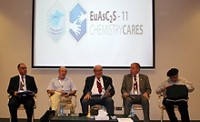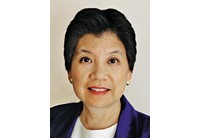Advertisement
Grab your lab coat. Let's get started
Welcome!
Welcome!
Create an account below to get 6 C&EN articles per month, receive newsletters and more - all free.
It seems this is your first time logging in online. Please enter the following information to continue.
As an ACS member you automatically get access to this site. All we need is few more details to create your reading experience.
Not you? Sign in with a different account.
Not you? Sign in with a different account.
ERROR 1
ERROR 1
ERROR 2
ERROR 2
ERROR 2
ERROR 2
ERROR 2
Password and Confirm password must match.
If you have an ACS member number, please enter it here so we can link this account to your membership. (optional)
ERROR 2
ACS values your privacy. By submitting your information, you are gaining access to C&EN and subscribing to our weekly newsletter. We use the information you provide to make your reading experience better, and we will never sell your data to third party members.
Careers
Building Bridges
Leading Chinese and U.S. Analytical Chemists gather for community building
by Celia Henry Arnaud
November 8, 2010
| A version of this story appeared in
Volume 88, Issue 45

Chinese analytical chemists are increasingly becoming integral members of the worldwide analytical chemistry community. This trend was apparent last month, when nearly 50 leading Chinese and U.S. analytical chemists gathered at Purdue University for the U.S.-China Analytical Chemistry Workshop. They set themselves the goals of strengthening bonds between the two communities and identifying ways to improve all aspects of the field, especially infrastructure and research, dissemination of results, and education.
“It was perhaps foolish to try to hold an international workshop in a 20-hour period,” said R. Graham Cooks, a chemistry professor at Purdue and one of the workshop organizers. “But I think we will have done what we set out to do and, in fact, a good deal more.”
The original idea for the workshop came from Cooks; Purdue biomedical engineering professor Zheng Ouyang; and Xinrong Zhang, professor of analytical chemistry at Tsinghua University, in Beijing. When Zhang approached Qianqun Zhuang, director of the Analytical Chemistry Division at the National Natural Science Foundation of China (NSFC), Zhuang immediately supported the idea. Zhang and Cooks became the driving forces for the workshop in their respective countries.
The Chinese organizers assembled a delegation representing a range of ages, institutions, and research interests. The group originally included 11 scientists in their 30s, 11 in their 40s, and six older than 50, representing top universities, national laboratories, and various state and government ministry labs. Visa hurdles and other personal issues, however, precluded the attendance of nearly half the delegates, including two officials from NSFC. Only 15 of the projected 28 Chinese representatives were able to attend.
The U.S. group included 33 analytical chemists, many of them from universities in the Midwest. The organizers scheduled the workshop to lead into the annual Midwestern Universities Analytical Chemistry Conference, offering the Chinese scientists an opportunity to interact with more of their U.S. counterparts than just the official workshop participants.
The main activities of the workshop centered around breakout groups that focused on the topics of literature and dissemination, research, infrastructure, and education. Participants shared experiences in the two countries in each of those areas. The breakout groups were charged with proposing concrete action items on one- and three-year timescales. Short-term items included gathering various types of data and organizing a follow-up workshop.
One area of focus was how to increase scientific exchange between the U.S. and China. Several participants noted that there is currently a “one way” flow of scientists from China to the U.S. They would like to find ways of encouraging U.S. professors and students to spend substantial blocks of time in China working with collaborators.
Cooks initially feared that the discussion might “stutter along,” but he was glad to see that it “sped along” instead. “People had an awful lot of things to say, and lots of good new ideas came out of it,” he told C&EN.
Funding on the U.S. side was provided by a grant from the National Science Foundation through the Chemistry Division’s International Collaboration in Chemistry (ICC) program. Kelsey D. Cook, program officer for the Chemistry Division’s chemical measurement and imaging program, participated in the workshop. The American Chemical Society and the Royal Society of Chemistry also provided financial support and sent representatives to the workshop.
“The Purdue workshop was meant to identify areas of research where our respective communities might find synergy,” NSF’s Cook said. “It was meant to compensate, in part, for the additional challenges posed by the extra geographical and cultural distance relative to most of our other ICC partners. The meeting had the feel of success, but of course, the test will come when the report is generated and follow-up becomes evident.”
Although an official report is not due until after the grant period, Purdue’s Cooks hopes to finish an account of the workshop by the end of this year. “That’s the only way to effectively use the people who were here in terms of recall,” he says.
A follow-up meeting is planned for next summer in Beijing. “If we end up gathering in Beijing and can’t tick off three or four major action items that we’ve addressed,” Cooks said, “I would be disappointed.”




Join the conversation
Contact the reporter
Submit a Letter to the Editor for publication
Engage with us on Twitter